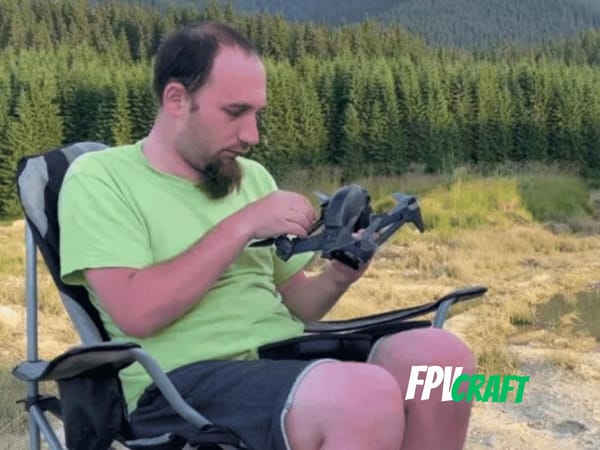Flying FPV Drones Indoors - Can you do it?
What are our opinions about flying FPV drones indoors? Can you do it? What type of FPV drone would you need for that? Let's find out together!

Drones are meant to be flown outdoors, including FPV Drones, because of the risks involved of crashing them into the walls if you fly your FPV drones indoors or damage any household items. But are you able to do it? Can you fly FPV Drones indoors?
Yes, in fact, FPV drones are the most common type of drone that can be flown indoors, but not all of them. Mainly, we are looking for microdrones and cinewhoops to fly indoors because of their size and safety frame. Still, not all microdrones are safe to fly indoors.
This being said, we should have a look together and find out everything to know about flying FPV Drones indoors and our recommendations.
Flying a standard-size FPV drone indoors – is it safe?
A standard-size FPV drone is usually a 3 to 5-inch drone (even bigger) and executes the FPV type of flights that may include acro, which are also very fast and dangerous.
We strongly do not recommend you fly these drones indoors at all, no matter what!
Not to mention, a classic FPV drone does not have any type of protection for propellers, and many accidents happen while flying these drones indoors. No matter how experienced you are in flying FPV, never fly a 5″ quad indoors.
What about other sizes of FPV Drones?
Unless you intend to fly micro drones, as well, we do not recommend trying even to lift off a drone of large size indoors. It isn’t worth the risk, to be honest.
If you want to configure your drone in betaflight or anything and test, for instance, turtle mode, or anything else related to the functionality, either do it without propellers, or if you try the turtle mode, do it outdoors.
Flying an FPV cinewhoop indoors – can you do it? Is it safe?
When we relate to cinewhoops, this is another story. Yes, you can fly cinewhoops indoors, but of course, at your own risk.
But before continuing, we have to understand what a cinewhoop is (also known as “whoops”)
A cinewhoop is a type of FPV drone that has a special frame where the propellers are not touching anything on impact because the frame safeguards them. – we can look, in this case, at the new DJI Avata – this is a cinewhoop type of drone.
A normal cinewhoop is the size of a standard FPV drone, which is relatively big. Because of its safety frame and slower flight speeds, we may think that it’s completely safe to fly it indoors, isn’t it?
Not quite; the drone is heavy, and most of them have over 500g in weight.
And you can knock out or break stuff inside your house if you lose control of a standard cinewhoop – therefore, do it at your own risk.
What about microdrones? Are you able to fly FPV microdrones indoors?
Yes and no.
Microdrones are, as they are named… microdrones. They are small and very lightweight, and you can fly them FPV. Microdrones do little to no damage, but we have to reflect on two types of microdrones.
The standard microdrones – are the same as classic FPV drones but only very tiny. These micro drones do not have any protection for the propellers and are slightly risky to fly around people and animals, especially indoors.
The Cinewhoop microdrones – are the most common type because they are built to be flown indoors, in small spaces, or outdoors without the need to fly them far.
Not to mention, microdrones (cinewhoops) are more resistant to minor crashes, which will often happen when you fly indoors.
How are you able to lift FPV Drones indoors?
An FPV Drone doesn’t have any kind of restrictions in place, such as a geolocation block, GPS signals, or anything else that may restrict you from lifting it up – for this reason, FPV pilots are basically able to lift FPV drones (and here we’re not talking about the DJI ones) anywhere, including indoors.
But this comes even at a higher risk because when we relate to FPV, we mostly relate to flying acro (or manual) mode, where you will have no control or whatsoever over hovering because you will have to stabilize the drone manually.
And to stabilize an FPV drone flying in acro mode to hover is not a beginner task. In fact, even the most advanced pilots will struggle to keep hovering an FPV drone in manual mode in the same spot.
What are the most recommended FPV drones (cinewhoops) to fly indoors?
If you insist on flying an FPV drone indoors and you have the space to do it, then I strongly recommend you to go only for the cinewhoop style of drones.
But more than that, the best cinewhoops to choose to have fun flying indoors are the microdrones we mentioned earlier.
Those come with 1s or 2s batteries, where the 1s cinewhoops are the smallest ones.
Please keep in mind that if you are looking to fly microdrones indoors, you need to know what to choose because you don’t want objects and walls to be blocking your signal to either your goggles or remote controller.
Although we may not be able to recommend specific products, to be able to fly FPV indoors, go for 1s microdrones, specifically for cinewhoops models (also named whoops).
Please do not forget to have a look at our safety warning page and read our website terms and conditions.
Can you do Roof Inspections Using an FPV Drone?




